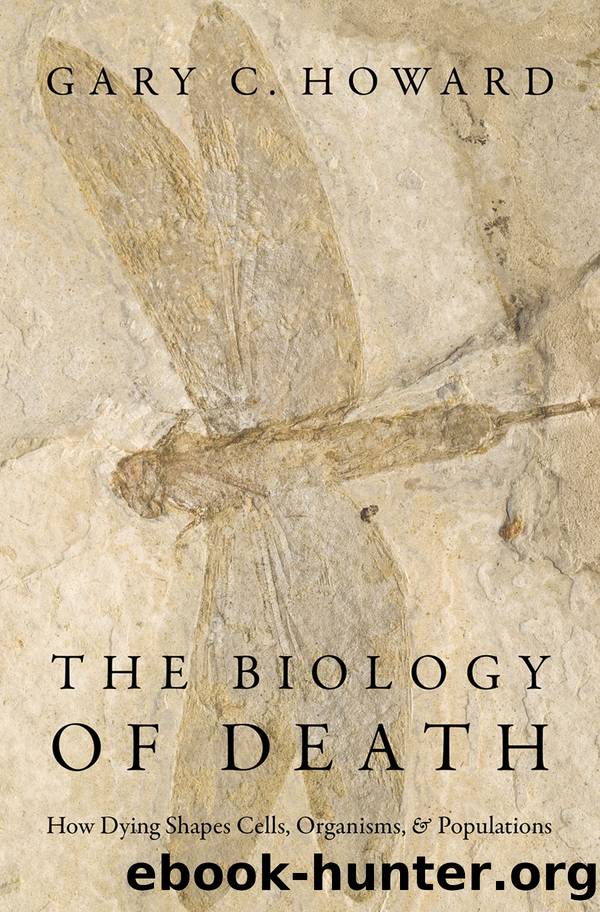The Biology of Death by Gary C. Howard

Author:Gary C. Howard
Language: eng
Format: epub
Publisher: Oxford University Press
Published: 2021-09-15T00:00:00+00:00
Anastasis: A Near-Death Experience for Cells
Once cells initiate apoptosis, is the death of the cell inevitable, or can the process be stopped and reversed? For some time, the scientific consensus was that once apoptosis was triggered, the process inevitably went through the full sequence, and the cell died; there was no turning back. However, more recent research shows that might not be the case. Apoptosis can be reversed, even at late stages after caspase release and mitochondrial fragmentation. The recovery of cells after apoptosis has been initiated is called anastasis (Sun and Montell 2017; Tang and Tang 2018, Gong et al. 2019). It can occur after a range of cellular threats, including cold shock, toxins, and protein starvation.
When the process of apoptosis fails, fewer caspases are released, and not all the cellâs mitochondria begin to leak cytochrome c at the same time, with the rest remaining intact. When this happens, apoptosis ends. The cells store away mRNAs before apoptosis begins, and those are used to restart normal cell processes. In anastasis, more than 1,000 genes are upregulated. But survival does not come without a cost to the cells. Cells that begin anastasis at late stages of apoptosis might not be completely healed. They may suffer from chromosome defects that can result in malignancy later. This may be especially relevant to cancer treatment, as treatments involving radiation and many chemotherapy drugs kill cancer cells by initiating apoptosis (Sun and Montell 2017). Some dying cancer cells may escape the treatment and begin anastasis. It is even possible that anastasis may promote metastasis.
While failed apoptosis is widely recognized, not everyone is convinced that anastasis is real. Obviously, it is difficult to know for certain if a specific cell initiated apoptosis. Also, caspases are used for multiple cell processes, and so their presence may not be a reliable marker for apoptosis. Supporters of anastasis point out that the other appearances of caspases are well defined in development, and their appearance at other, more random times might support the presence of anastasis. All agree that more work is needed to come to a final conclusion.
Other forms of cell death besides apoptosis may be reversible as well. In necroptosis, which is associated with trauma and stress, a protein called mixed lineage kinase-like protein causes holes in the plasma membrane. Those holes can be limited by the ESCRT III complex (Gong et al. 2017). Ferroptosis cannot be stopped by removing the initiating stress, but it can be if lipophilic antioxidants or chelators are also introduced (Tang and Tang, 2019). In entosis, the engulfment of one cell by another, the engulfed cell is usually killed by autophagy and dismantled for recycling by lysosomes, but sometimes it survives and might even reproduce (Hamann et al. 2017). If it does reproduce, the result can sometimes be aneuploidy (extra chromosomes).
Download
This site does not store any files on its server. We only index and link to content provided by other sites. Please contact the content providers to delete copyright contents if any and email us, we'll remove relevant links or contents immediately.
Sapiens: A Brief History of Humankind by Yuval Noah Harari(13037)
The Tidewater Tales by John Barth(12026)
Do No Harm Stories of Life, Death and Brain Surgery by Henry Marsh(6332)
Mastermind: How to Think Like Sherlock Holmes by Maria Konnikova(6224)
The Thirst by Nesbo Jo(5778)
Why We Sleep: Unlocking the Power of Sleep and Dreams by Matthew Walker(5636)
Sapiens by Yuval Noah Harari(4528)
Life 3.0: Being Human in the Age of Artificial Intelligence by Tegmark Max(4492)
The Longevity Diet by Valter Longo(4443)
The Rules Do Not Apply by Ariel Levy(3897)
The Immortal Life of Henrietta Lacks by Rebecca Skloot(3820)
The Body: A Guide for Occupants by Bill Bryson(3789)
Why We Sleep by Matthew Walker(3767)
Animal Frequency by Melissa Alvarez(3750)
Yoga Anatomy by Kaminoff Leslie(3696)
Barron's AP Biology by Goldberg M.S. Deborah T(3628)
The Hacking of the American Mind by Robert H. Lustig(3575)
All Creatures Great and Small by James Herriot(3506)
Yoga Anatomy by Leslie Kaminoff & Amy Matthews(3392)
